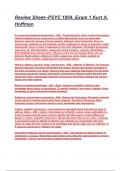Review Sheet--PSYC 1004, Exam 1 Kurt A.
Hoffman
6 current psychological perspectives - ANS - Psychodynamic: focus on the unconscious;
clinical problems due to unconscious conflicts Behaviorist: focus on observable
behavior; behavior changes through learning. (behavior only) Humanistic: focus on
self-concept, realizing our full potential, and the challenges in doing so Cognitive: unlike
behaviorism, focus on what is happening in the mind, thoughts, information processing,
memories, etc. (Psychometrics: measuring mental functions, capacity, Alfred Binet ---
first intelligent test.) Neuroscience: influence of the nervous system (brain, etc.) on
behavior Social-culture: influence of other people (e.g. peers, family, society) on
behavior; often involves comparing and contrasting cultures
Afferent, efferent, sensory, motor, interneurons - ANS - Afferent: In Efferent: Out Sensory:
Neurons that carry incoming information from body's tissues and sensory receptors to
the brain and spinal cord. Motor: Neurons that carry outgoing information from the brain
and spinal cord to the muscles and glands. Interneurons: Neurons within the brain and
spinal cord; they communicate internally and process information between the sensory
inputs and motor outputs.
Basic and applied psychology - ANS - Basic: Using the scientific method to gain
knowledge about topics in psychology. (To satisfy curiosity, learn more.) Applied: Using
knowledge to solve and prevent human problems.
Bottom-up and top-down processing - ANS - Bottom Up Processing: Perceptions formed
as the result of combing inputs about basic features. Top Down Processing: Brain
Interprets sensory information based on prior knowledge and expectations.
Culture, cognitive dissonance, and preferences regarding formal and informal ways to
address others - ANS - Culture: Interrelated set of beliefs, values, norms and habits in a
group of people sharing some common identity. We often seem to notice differences
based on culture. Cognitive dissonance: Mental discomfort that occurs when a behavior
is inconsistent with an attitude or belief (or two attitudes are inconsistent with each
other) we might feel this if asked to do something that doesn't align with our attitudes, or
if someone points out a "mistake" we made.
Descriptive methods used by psychologists - ANS - Case studies (in-depth analysis of
individuals or groups). Naturalistic observations (recording the natural behavior of many
individuals). Surveys and interviews (asking people questions).
, Divisions and structures of the nervous system: A. Peripheral 1. Somatic - ANS - Think of
it as 'voluntary' N.S. Sensory and motor neurons.
Divisions and structures of the nervous system: A. Peripheral 2. Autonomic - ANS -
Controls automatic processes, like breathing, body temp. Two subdivisions:
a. Sympathetic Activates Fight-or-flight response. b. Parasympathetic Active more often
Controls normal operations and calms the body
Divisions and structures of the nervous system: B. Central 1. Brain - ANS - 'Lower'
structures (toward spinal cord) carry out basic life process ... hindbrain, midbrain
'Higher' structures carry out complex cognitive function ... mostly forebrain. a. Hindbrain
& Midbrain Structures M - Cerebellum: Balance and coordinated movement. M - Medulla:
Heart Rate and breathing M -Pons : Sleep and arousal; balance, coordinated movements,
and some hearing. M Also the reticular formation: arousal and attention. -Midbrain
(Above pons): Helps vision and audition, for example, by fixing gaze even as your head
moves; aids basic movements for sex and aggression. b. Forebrain Structures i.
subcortical structures - Thalamus: Relay station - Hypothalamus: Autonomic info;
homeostasis. This study source was downloaded by 100000832330818 from
CourseHero.com on 09-18-2021 22:30:19 GMT -05:00
https://www.coursehero.com/file/38687671/Exam-1-Review-Sheet-2019docx/ This study
resource was shared via CourseHero.com - Limbic system: Hippocampus: Vital for
memory/learning Amygdala: Emotion center (emotion & learning, emotion recognition) ii.
cerebral cortex --- what it is, 4 lobes - 2-3 mm thick. - Wrinkled and convoluted --- MUCH
surface area. - Controls complex and abstract thought. 1. Frontal Lobes: Thoughts,
plans, language 2. Parietal Lobes: Touch 3. Temporal Lobes: Hearing, language 4.
Occipital Lobes: Vision importance of assoc. areas, inhibition (Phineas Gage), plasticity,
cerebral lateralization 1. In humans, about 75% of cortical mass is association area ---
deciphering/integrating current information and deciding what to do about it. 2. Our
brains, especially frontal lobes, help us inhibit behavior. 3. The cortex is plastic, can
respond to drastic change or damage 4. Cerebral cortex has 2 halves, the left and right
hemispheres. Connected by the corpus callosum Sensory and motor pathways 'cross
over', so L si
Divisions and structures of the nervous system: B. Central 1. Spinal Cord - ANS - Reflex
responses Relay to/from brain
Figure-ground, Gestalt principles of perceptual organization, monocular cues for depth
perception - ANS - Figure-ground: The organization of visual field into objects (the
figures) that stand out from their surroundings (the ground). Gestalt principles of
perceptual organization: Believed people perceive sights and sounds as organized
wholes, not just sums of individual sensations. 1. Law of Proximity--elements that occur
close together are perceived as a group. This study source was downloaded by
100000832330818 from CourseHero.com on 09-18-2021 22:30:19 GMT -05:00
https://www.coursehero.com/file/38687671/Exam-1-Review-Sheet-2019docx/ This study




